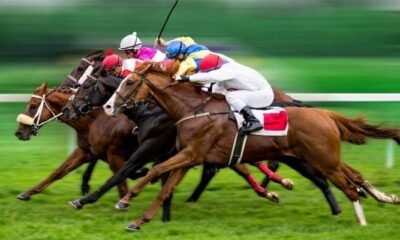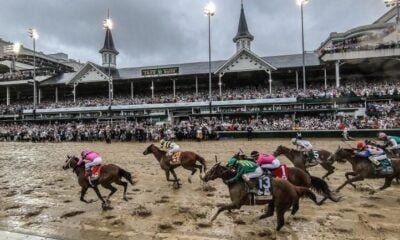
How to Train Racehorse is a complex and demanding process that requires dedication, expertise, and patience. Whether you’re a professional trainer or a passionate owner, this guide will provide you with valuable insights and tips to help you train your racehorse to reach its full potential.
Table of Contents
1. Establish a Solid Foundation
Before diving into intense training sessions, it’s crucial to establish a solid foundation for your racehorse. This includes ensuring that your horse is in good health, has received appropriate vaccinations, and is free from any injuries or ailments that could hinder its performance.
Additionally, it’s essential to build a strong bond with your horse through regular grooming, handling, and spending quality time together. This will help establish trust and create a positive training environment.
2. Develop a Training Plan
Creating a well-structured training plan is key to the success of your racehorse. Consult with a professional trainer to develop a customized plan that takes into account your horse’s age, fitness level, and racing goals.
The training plan should include a combination of cardiovascular exercise, strength training, and skill development. Gradually increase the intensity and duration of each training session to avoid overwhelming your horse and minimize the risk of injuries.
3. Focus on Conditioning on How to Train Racehorse
Conditioning plays a vital role in preparing a racehorse for the demands of racing. Regular exercise, such as long gallops and interval training, helps improve cardiovascular fitness, muscle strength, and endurance.
Incorporate hill work and swimming sessions into your training routine to enhance your horse’s overall fitness and stamina. These activities also provide a change of scenery and help prevent boredom.
4. Implement a Balanced Diet
A well-balanced diet is crucial for a racehorse’s overall health and performance. Consult with an equine nutritionist to develop a diet plan that meets your horse’s specific nutritional needs.
The diet should consist of high-quality forage, such as hay and pasture, supplemented with appropriate amounts of grains, proteins, vitamins, and minerals. Regularly monitor your horse’s weight and adjust the diet accordingly to maintain optimal body condition.
5. Incorporate Mental Stimulation
Training a racehorse isn’t just about physical conditioning; mental stimulation is equally important. Engage your horse in various activities, such as trail rides, obstacle courses, and ground exercises, to keep its mind sharp and prevent boredom.
Introduce new challenges gradually to build your horse’s confidence and problem-solving abilities. This will help your horse stay focused during races and adapt to different track conditions.
6. Monitor Progress and Adjust Accordingly
Regularly assess your horse’s progress and make necessary adjustments to the training plan. Keep detailed records of each training session, including distance covered, speeds, and any observations or concerns.
Work closely with your veterinarian and farrier to ensure your horse’s overall health and soundness. Regular check-ups, dental care, and hoof maintenance are essential for preventing any potential issues that could impact performance.
7. Patience and Consistency
Training a racehorse is a journey that requires patience and consistency. It’s important to remember that each horse is unique and may progress at its own pace.
Be patient with your horse and celebrate small victories along the way. Consistency in training, feeding, and handling will help build trust and create a routine that your horse can rely on.
Remember to listen to your horse and make adjustments as needed. If your horse shows signs of fatigue or discomfort, give it the necessary rest and consult with professionals to address any underlying issues.
A racehorse needs a lot of training before a racecourse event. To train racehorse in the early weeks, the horse should be galloped and worked on the straightaways. The horse should be given time to relax in between workouts. During the middle weeks, the horse should be galloped and worked on the turns. The horse should also be given time to relax in between workouts. In the final weeks, the rider of a racehorse needs to find the right balance between working a horse too hard and letting a horse rest in-between workouts. This is done in order to help the horse prepare better for a racecourse event.
Many prerequisites go into being the best horse trainer. For example, it is important to have a veterinary degree or two to provide good care for the horses. A trainer should also have an understanding of the psychology of horses, be conversational in several languages, be well-versed in equine health issues and general horse knowledge so they can provide good advice on dieting, training methods and equipment needs.
The best trainers also know how to communicate with their owners and stable staff. They keep everyone up-to-date on the horse\’s condition and needs and work as a team to provide the best care for the horses. There is a lot of work to be a successful horse trainer, but it can be very rewarding. Horse trainers are responsible for helping to bring out the horse\’s highest potential so that they can excel at their given sport.
The best trainer may not always be the one that knows all of the latest training techniques or has just bought a new piece of equipment. The best trainer is usually the one that has spent time with his horses and knows them inside and out. He can read their body language and knows when to push them and when to back off. The best trainer is patient, kind, and has a good sense of humour. Horses are very intelligent animals and respond well to positive reinforcement. If you can find a trainer that possesses all of these qualities, then you have found yourself a real treasure!
A racehorse needs to be fast and strong. The racehorse should also have a calm temperament and be intelligent. A horse that can think and react quickly is usually the type of horse that wins races. The horse needs to be worked out regularly to make a racehorse as fast and strong as possible. A racehorse that is not routinely exercised will not run as fast or as hard during a racecourse event.
A racehorse owner needs to find the right trainer. The trainer should work out a racehorse and make sure that the racehorse is fast and strong. The trainer should also have a good understanding of a horse\’s instincts so that they can train a horse so that the horse will always run in its best interest.
In order for a racehorse to keep healthy, it is important for the horse to be kept hydrated. The horse should also be groomed regularly. This will help keep the horse\’s coat healthy and shiny. In addition, the racehorse should have its hooves trimmed so that it can run smoothly on a racecourse event.
One of the most important ways to make sure a racehorse does not injure itself is to ensure that the trainer has experience. A competent trainer will know how to do their job well and will also be able to think quickly. For example, a racehorse may stumble on a stone, causing its ankle to become injured. For this injury to heal properly, the horse needs time off from running. The trainer will need to figure out when enough is enough and put the horseback on the track at an appropriate time to recover without re-injuring itself.
A racehorse owner should try to find a person who has experience with these types of injuries to prevent them from happening again. A good trainer will know how to prevent injuries from happening and will also be able to treat an injury if it does occur.
Thoroughbreds are best for racing. However, for individuals looking to practice how to train a horse, Thoroughbreds are expensive. Individuals can first start with Quarter Horses or some other types of horses. This is because these types of horses are not as expensive as Thoroughbreds. Once you have gained experience in training horses for racing, you can then train Thoroughbreds.
A thoroughbred horse is a breed of horse that is known for its speed and agility. These horses are bred for racing and can reach speeds of up to 40 miles per hour. Thoroughbreds are also known for their muscular build and long legs. Their distinctive features can be easily recognized, including their thin heads, large eyes, and arched necks.
It is believed that a horse’s success in horse racing is dependent on several factors. Some of these factors include the horse’s natural abilities, the trainer’s ability to train the horse, and the care that the horse receives. For a horse to be successful in horse racing, the horse needs to have a lot of stamina and speed. It is also important for the horse to be comfortable with running long distances.
One of the most important factors that determine a horse’s success in horse racing is the care that the horse receives. The horse’s diet is very important, and the horse should be given plenty of exercises. To ensure that the horse is healthy, the trainer must keep a close eye on the horse’s daily routine. The care that the horse receives is very important to his success in the tracks.
Another factor that determines a horse’s success in horse racing is the opportunity for exercise. A racehorse should receive plenty of exercises, and this will ensure that he stays healthy and strong. The trainer should make sure that the racehorse exercises daily. The horse trainer should also make sure that the horse is not stressed out or injured during exercise.
A racehorse’s diet is very important for his overall health and well-being. The horse’s diet needs to be carefully planned so that he can develop well and remain healthy. To ensure proper development, the racehorse’s diet should include a lot of protein. The horse trainer should make sure that the racehorse gets enough carbohydrates and fiber as well.
The first step towards a successful career as a racehorse owner is to invest in the purchase of an exceptional yearling from a top bloodstock agency or stud farm. When you buy a yearling, you are purchasing a young racehorse that is old enough to be trained but still young enough to grow and develop before starting his or her competitive career.
Another thing that every racehorse owner should do is join the relevant racing body. There are many racing bodies in different countries across the world, but most are some type of local governing or regulatory body. Joining the relevant racing body gives you access to information about racecourses, rules, and regulations, as well as updates on races and results.
So to get the best out of your racehorse, it is a combination of excellent efforts of the trainer along with good traits of your racehorse coupled with the experience of a jockey. A jockey\’s job is to run the horse for the race. The jockey can also visit the stables to make sure that all equipment is in order. A good jockey will calm the horse before they get on, then guide them into a focused frame of mind. It is important that the jockey leads by example and stays focused throughout the racecourse.
A good jockey must know the horse very well to ride them effectively. They will usually see the horse\’s quirks and how to handle them on the racecourse. A successful jockey must also be in excellent physical condition, as they will be required to stay in the saddle for a long period.
Before any race event, a horse needs to be well-rested and calm. If a horse is worked too hard or too much before a race, the horse could become exhausted and may not perform well on the racecourse. A good way to help a horse relax is by taking them for a long walk or just letting them graze in the grass. If you should choose, you could also decide to put your horse on an exercise machine called a treadmill. The treadmill can help your horse stay loose before the race begins.
It is important to work with a qualified trainer when training a racehorse. A good trainer can help you determine the best way to work your horse and will be able to guide you in the right direction. Remember, it takes a lot of time and effort to train a racehorse and get them ready for a racecourse event. Be patient and stay dedicated to your goal of preparing a successful racehorse!
Thank you for reading! I hope this article has helped give you some tips on how to train your racehorse. Good luck, and I wish you the best of luck in all your future races!
Conclusion
Training a racehorse is a challenging yet rewarding endeavor. By establishing a solid foundation, developing a customized training plan, focusing on conditioning and nutrition, incorporating mental stimulation, monitoring progress, and maintaining patience and consistency, you can set your racehorse up for success.
Remember, each horse is unique, and their training journey will be different. Adapt your approach to suit your horse’s individual needs and always prioritize their well-being above all else.


Must See
-


Racing Events
/ 2 years agoBiggest Horse Racing Events around the World
This article will be discussing 10 of the biggest horse racing events happening throughout...
By Robia Sarah












